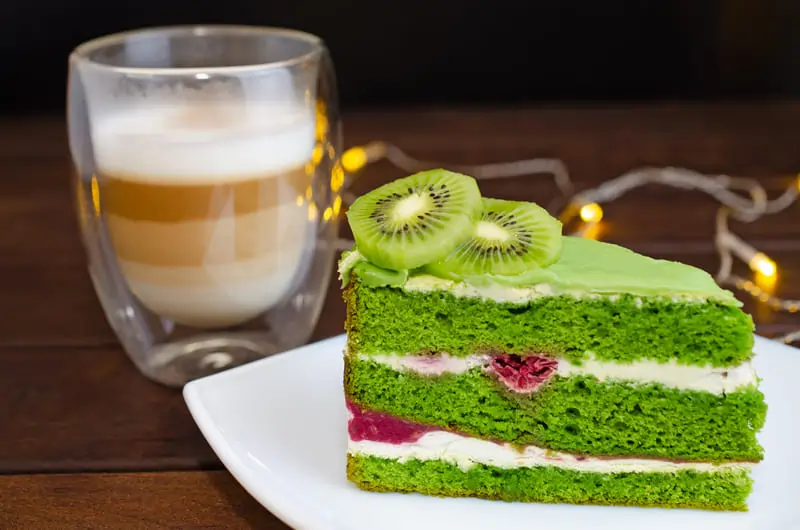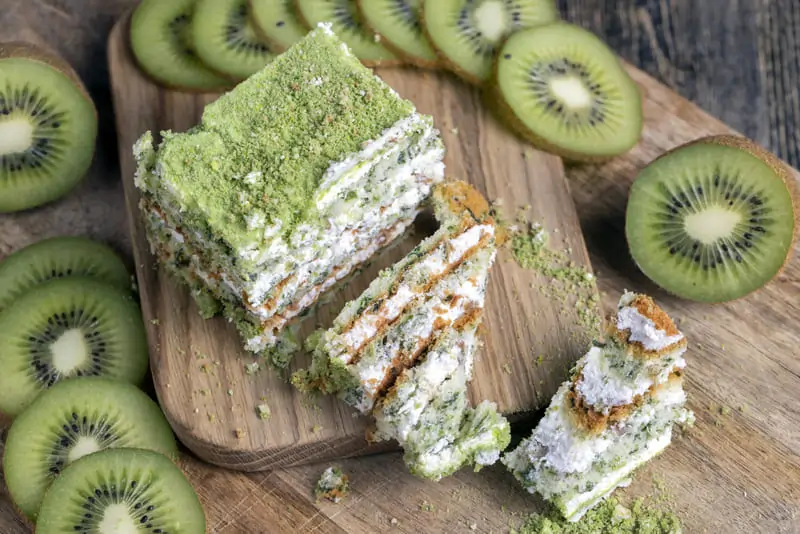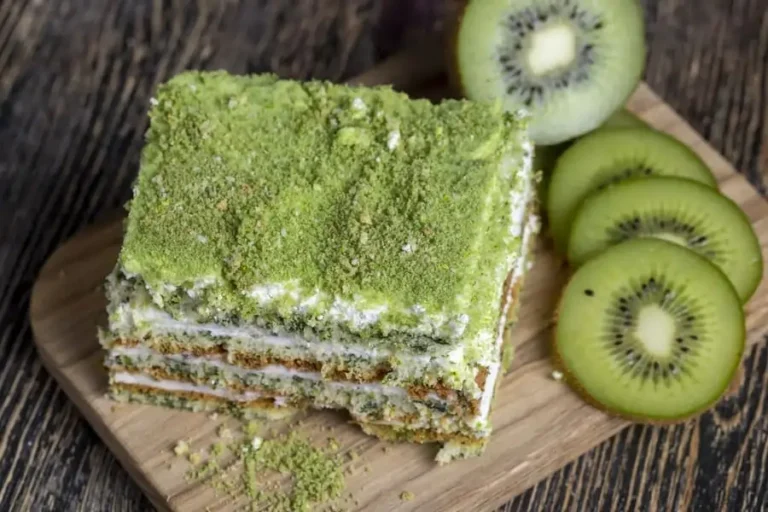Matcha tiramisu is a delightful fusion dessert that combines the rich creaminess of Italian tiramisu with the earthy tones of Japanese matcha. This dessert has gained immense popularity as matcha continues to take center stage in the world of modern cuisine. In this article, you’ll discover the key ingredients, step-by-step preparation, and variations of this unique dessert. For those who love desserts that blend cultures, Matcha Tiramisu: A Perfect Fusion of Japanese and Italian Flavors offers inspiration.
What is Matcha Tiramisu Made Of?
Matcha tiramisu is a modern, elegant spin on the traditional Italian dessert, incorporating the rich flavors of matcha powder, a finely ground Japanese green tea, in place of coffee. This refreshing twist creates a dessert that’s visually stunning and full of unique, layered flavors. Here’s a detailed look at the key ingredients that make this vibrant treat so irresistible:
1. Matcha Powder
The star ingredient of matcha tiramisu is high-quality matcha powder, known for its earthy, slightly bitter flavor and vibrant green color. Matcha replaces the espresso used in classic tiramisu, infusing the dessert with a subtle tea flavor while adding a signature aesthetic appeal. For the best results, use ceremonial-grade matcha, as it provides a smoother taste and a brighter hue compared to lower-grade alternatives.
If you’re new to working with matcha, explore this guide to choosing and using matcha powder to ensure your dessert achieves the perfect balance of flavor and color.
2. Ladyfingers (Savoiardi)
These light, sponge-like biscuits play a key role in forming the layers of matcha tiramisu. Soaked in a matcha syrup—a blend of matcha powder, hot water, and sugar—ladyfingers absorb the liquid and soften, creating a flavorful and delicate foundation. The biscuits maintain their structure while melding beautifully with the creamy layers.
To prevent soggy layers, dip the ladyfingers briefly into the matcha syrup, just enough to coat the surface without oversaturating.
3. Mascarpone Cheese
Mascarpone cheese is an essential element of tiramisu, delivering a rich, creamy texture that balances the bitterness of the matcha. Its luxurious mouthfeel creates a smooth, indulgent base for the dessert. When combined with whipped cream and sugar, mascarpone transforms into a light and airy cream that complements the soaked ladyfingers perfectly.
4. Heavy Cream or Whipped Cream
Heavy cream is whipped to soft peaks and gently folded into the mascarpone mixture to achieve a light and fluffy consistency. This step is crucial for balancing the density of the mascarpone cheese, giving the cream layer a cloud-like texture while still feeling indulgent.
For those who enjoy experimenting, a touch of vanilla extract can be added to the whipped cream for a subtle sweetness that enhances the matcha flavor.
5. Sugar
Sugar plays a vital role in matcha tiramisu by balancing the natural bitterness of the matcha powder. It sweetens the mascarpone cream and matcha syrup, ensuring the dessert has a harmonious blend of flavors. Adjust the sugar to your preference to achieve the perfect level of sweetness.
6. Optional Ingredients
For an extra layer of flavor, you can add a splash of alcohol such as rum, amaretto, or even matcha liqueur to the matcha syrup. This addition gives the dessert a subtle kick, similar to the traditional tiramisu, making it even more indulgent.
Bringing It All Together
These ingredients come together in layers: matcha-soaked ladyfingers alternating with light mascarpone cream, topped with a dusting of matcha powder for a finishing touch. The result is a sophisticated dessert that’s both rich and refreshing, with a balance of earthy, creamy, and sweet flavors.
For more creative recipes that put a modern spin on classic desserts, check out this guide on How to Make the Perfect Apple Cherry Pie. Like matcha tiramisu, it showcases how traditional flavors can be reimagined into something new and exciting.
Step-by-Step Guide to Make Matcha Tiramisu

Creating matcha tiramisu at home is a simple and rewarding process that combines creamy textures with the earthy flavor of Japanese green tea. Follow this detailed guide to ensure your dessert comes out perfect every time.
1. Prepare the Matcha Soaking Mixture
The matcha soaking mixture is key to infusing the ladyfingers with the signature green tea flavor:
- In a small bowl, whisk 2 tablespoons of matcha powder with 1 cup of warm water (not boiling, to avoid bitterness).
- Add 2 tablespoons of sugar and whisk vigorously until the matcha and sugar are fully dissolved. For a smoother consistency, sift the matcha powder beforehand to eliminate clumps.
The result should be a slightly sweet, vibrant green mixture that’s ready for dipping. For tips on working with matcha, check out this matcha preparation guide.
2. Make the Mascarpone Cream
The mascarpone cream provides the rich, velvety layers that balance the bold matcha flavor:
- In a large bowl, whip 1 cup of heavy cream with 2 tablespoons of sugar using a hand mixer or whisk. Continue whipping until soft peaks form—light and fluffy but not overly stiff.
- Gently fold in 8 oz of mascarpone cheese using a spatula. Be careful not to overmix, as this can deflate the cream. The result should be smooth, creamy, and well-incorporated.
For added flavor, a splash of vanilla extract can enhance the mascarpone cream, providing subtle sweetness without overpowering the matcha.
3. Soak the Ladyfingers
The trick to achieving the perfect texture is dipping the ladyfingers quickly:
- Lightly dip each ladyfinger (savoiardi biscuit) into the prepared matcha mixture for 1–2 seconds.
- Avoid oversoaking, as the biscuits will become too soft and lose their structure. The ladyfingers should be moist on the outside but still firm enough to hold shape.
4. Layer the Dessert
Now comes the fun part—assembling the tiramisu layers:
- Start with a layer of matcha-soaked ladyfingers at the base of your serving dish or individual cups. Arrange them evenly to form a solid foundation.
- Spread a generous layer of the mascarpone cream over the ladyfingers, smoothing it out with a spatula.
- Repeat the process: Add another layer of matcha-soaked ladyfingers followed by mascarpone cream.
- Finish with a final layer of mascarpone cream on top for a smooth and elegant finish.
5. Dust with Matcha Powder
The final dusting of matcha powder adds both flavor and visual appeal:
- Use a fine mesh sieve to sift a thin, even layer of matcha powder over the top of the mascarpone cream.
- For best results, dust the matcha powder just before serving to preserve its vibrant green color.
This final touch creates a professional, Instagram-worthy appearance while enhancing the dessert’s earthy matcha flavor.
6. Chill and Serve
Refrigerate the assembled tiramisu for at least 4 hours (or overnight) to allow the flavors to meld and the layers to set properly. Chilling ensures a firm texture, making it easier to slice and serve clean portions.
When ready to serve, garnish with a sprig of fresh mint or a drizzle of white chocolate for added flair.
Why You’ll Love This Recipe
This matcha tiramisu strikes the perfect balance of creamy, earthy, and slightly sweet flavors, making it ideal for dinner parties, family gatherings, or a personal treat.
For more simple and delicious recipes, try these 4-Ingredient Peanut Butter Cookies. Like matcha tiramisu, they demonstrate how a few quality ingredients can come together to create something delightful and satisfying.
Variations of Matcha Tiramisu

Matcha tiramisu is highly adaptable, making it easy to customize based on dietary preferences or creativity. Here are some popular variations to try:
- Eggless Matcha Tiramisu: Skip the eggs and focus on whipped cream and mascarpone for a light, smooth texture.
- Gluten-Free Matcha Tiramisu: Use gluten-free ladyfingers or sponge alternatives to cater to gluten-sensitive diets.
- Vegan Matcha Tiramisu: Replace mascarpone with whipped coconut cream and use almond or oat milk for the matcha soaking mixture. This creates a dairy-free, plant-based version of the dessert.
- Low-Sugar Option: Reduce the sugar content by incorporating natural sweeteners like stevia or monk fruit. Adjust the sweetness to complement matcha’s bitterness.
These variations allow you to enjoy matcha tiramisu in ways that suit your taste and lifestyle.
Tips for Choosing the Best Matcha Powder
Using high-quality matcha powder is essential for creating the perfect matcha tiramisu. Matcha’s flavor, aroma, and color can significantly impact your dessert’s overall quality and presentation. Here’s a detailed guide to help you choose the right matcha and store it properly to achieve exceptional results.
1. Ceremonial Grade vs Culinary Grade
When selecting matcha powder, it’s important to understand the difference between ceremonial-grade and culinary-grade matcha:
- Ceremonial Grade:
- This is the highest quality matcha, traditionally used in Japanese tea ceremonies.
- It has a vibrant green color, a smooth texture, and a naturally mild, sweet flavor without bitterness.
- Ceremonial-grade matcha is ideal for delicate desserts like matcha tiramisu, as it adds a refined taste and bright green hue that enhances presentation.
- Culinary Grade:
- Culinary-grade matcha is slightly bitter and less vibrant, making it better suited for baked goods and recipes where matcha is mixed with other strong flavors.
- It’s a more cost-effective option but may lack the brightness and smooth flavor profile of ceremonial-grade matcha.
For desserts that highlight matcha, such as tiramisu or mousse, ceremonial-grade matcha is worth the investment for its superior taste and visual appeal. If you’re using matcha for baked recipes, culinary-grade can work without compromising results.
To explore more about matcha quality, check out this guide to choosing the right matcha for cooking and desserts.
2. Color and Aroma
The quality of matcha can also be judged by its color and aroma:
- Bright Green Hue: High-quality matcha should have a vivid, almost neon-green color, which indicates freshness and proper processing. Dull or yellowish matcha typically signals low-grade powder or oxidation.
- Earthy, Fresh Aroma: Fresh matcha emits a mild, grassy, and slightly sweet aroma. A stale or bitter smell suggests the matcha is past its prime and may not deliver the desired flavor.
When shopping for matcha, inspect its color carefully and take note of its aroma to ensure you’re purchasing a high-quality product.
3. Storage Tips for Freshness
Proper storage is crucial to maintaining the flavor, color, and potency of matcha powder over time:
- Use an Airtight Container: Store matcha in an airtight container to prevent exposure to air, which can lead to oxidation and loss of flavor.
- Keep Away from Heat and Sunlight: Matcha is sensitive to heat and light, which can degrade its vibrant color and nutrients. Store it in a cool, dark place, like a pantry or refrigerator.
- Minimize Moisture Exposure: Always use a dry spoon to scoop matcha powder, as moisture can cause clumping and spoil the texture.
For long-term storage, consider keeping matcha in a resealable bag within an opaque container to maintain its peak freshness.
Why Matcha Quality Matters
High-quality matcha not only enhances the flavor of your dessert but also elevates its presentation with a vibrant green hue. The smooth, slightly sweet flavor of ceremonial-grade matcha balances beautifully with the creamy mascarpone in matcha tiramisu, creating a dessert that feels indulgent yet refreshing.
If you’re looking for more recipes that showcase high-quality ingredients, explore this guide on perfecting classic desserts like Apple Cherry Pie.
Common Mistakes When Making Matcha Tiramisu
Matcha tiramisu is a stunning and flavorful dessert, but small mistakes can easily affect its texture, presentation, and taste. To help you perfect this elegant fusion dish, here are common pitfalls to avoid and tips to get it right every time.
1. Over-Soaking the Ladyfingers
The key to achieving a well-balanced texture lies in how you soak the ladyfingers (savoiardi):
- Dip the ladyfingers quickly—just 1–2 seconds—into the matcha soaking mixture. Ladyfingers are light and porous, so they absorb liquid quickly. Over-soaking leads to a soggy, mushy texture that can ruin the structure of the tiramisu.
- The biscuits should be moist on the outside but remain firm enough to hold their shape when layered.
Pro Tip: Use a shallow dish for the matcha mixture and gently turn the ladyfingers for even coating without oversaturating.
For more tips on creating flawless layers, check out this guide to assembling the perfect tiramisu.
2. Using Low-Quality Matcha
The quality of your matcha powder can make or break your matcha tiramisu:
- Low-quality or culinary-grade matcha tends to have a dull green color and a more pronounced bitterness. This can overshadow the delicate flavors of the mascarpone cream.
- Always opt for ceremonial-grade matcha for desserts. It offers a smoother flavor, vibrant green hue, and no unpleasant aftertaste.
If you’re unsure how to select the right matcha, explore this matcha powder buying guide for detailed tips on choosing the best quality for your recipes.
3. Over-Whipping the Cream
The mascarpone cream is the heart of the tiramisu, providing its signature rich and velvety texture. Over-whipping the cream or mascarpone can lead to an unpleasant curdled texture:
- Whip the heavy cream only until soft peaks form—light and airy but not stiff.
- When combining whipped cream with mascarpone cheese, gently fold them together using a spatula. Overmixing at this stage can deflate the cream and cause it to separate.
To ensure a smooth consistency, bring mascarpone cheese to room temperature before mixing. This helps it blend more easily with the cream.
Additional Tips for Success
- Don’t Skip the Chilling Time: Refrigerate the tiramisu for at least 4 hours (or overnight). This allows the flavors to meld, the layers to set, and the dessert to firm up for easy slicing.
- Dust Matcha Powder Carefully: Use a fine mesh sieve to evenly dust matcha powder on top, and do this just before serving to preserve its vibrant green color.
For more dessert tips and creative recipes, check out this guide on how to make easy yet impressive 4-Ingredient Peanut Butter Cookies.
FAQs About Matcha Tiramisu
1. What makes matcha tiramisu unique compared to classic tiramisu?
Matcha tiramisu uses matcha instead of coffee, giving it a vibrant color and earthy flavor. To explore the fusion of flavors, check out Matcha Tiramisu: A Perfect Fusion of Japanese and Italian Flavors.
2. Can I use regular green tea instead of matcha powder?
No, regular green tea does not have the concentrated flavor or fine texture of matcha powder. For tips on ingredient substitutions, you might enjoy Banana Bread Cookies: The Perfect Fusion of Two Desserts.
3. Is matcha tiramisu healthier than traditional tiramisu?
While matcha provides antioxidants, the dessert still contains cream and sugar. If you’re looking for healthier dessert options, try this 4-Ingredient Peanut Butter Cookies.
4. How long does matcha tiramisu last in the fridge?
It stays fresh for 3-4 days when stored properly in an airtight container. Discover more baking tips with How to Make the Perfect Apple Cherry Pie.
5. Can I make matcha tiramisu without mascarpone cheese?
Yes, you can substitute it with cream cheese or coconut cream for a lighter alternative. Explore unique recipe tweaks and creative inspiration in Matcha Tiramisu: A Perfect Fusion of Japanese and Italian Flavors.
Conclusion
Matcha tiramisu is a beautiful blend of Italian and Japanese culinary traditions. With its creamy mascarpone layers and earthy matcha powder, it’s a dessert that appeals to both classic and modern dessert lovers. Whether you follow the traditional recipe or try a creative variation, this dish is sure to impress. If you’re curious about other creative recipes, explore more like Banana Bread Cookies: The Perfect Fusion of Two Desserts.

